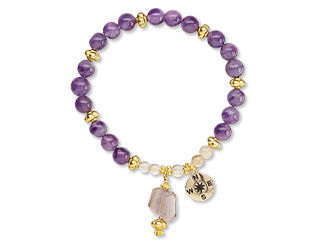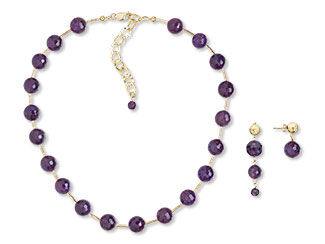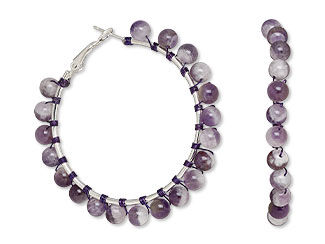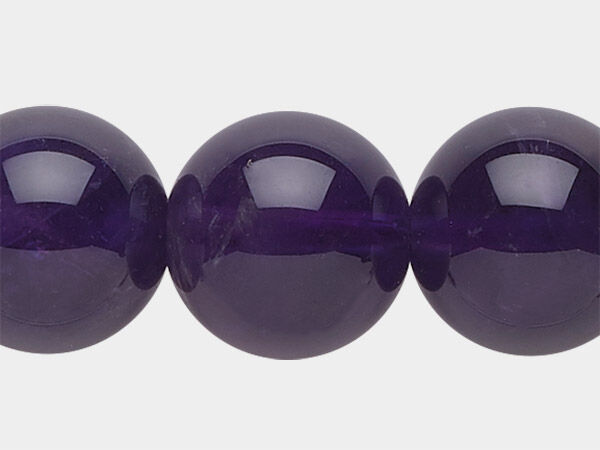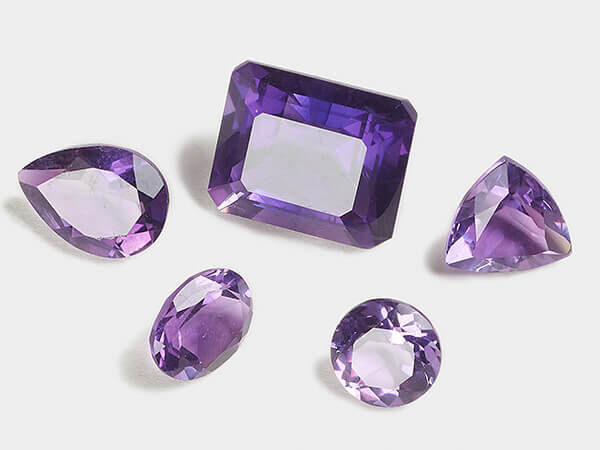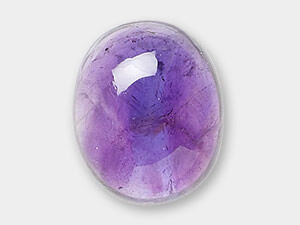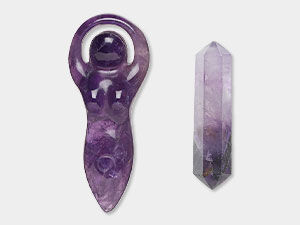Amethyst Meaning and Properties
Amethyst History
Amethyst (pronounced AM-eh-thihst) is one of the most common—and popular—gemstone materials. This variety of quartz ranges in color from deep purple to pale lavender depending on the presence of manganese and iron.
The origin of this gemstone, according to the ancient Greeks, was the nymph Amethystos. She resisted the advances of Dionysus, god of wine and revelry, praying for protection. The virgin goddess Artemis answered, transforming her into a clear or white stone. Dionysus, in despair or regret, poured wine over it—dyeing the crystal purple and creating what we now know as amethyst.
With purple being the color of royalty in the ancient Mediterranean, amethyst quickly became a symbol of power and wealth. It adorned the robes and crowns of monarchs and was valued as highly as ruby, emerald, and sapphire. Amethyst continues to hold court in the regalia of royalty and religious leaders alike—including pieces in the British Crown Jewels and those worn by officials in the Church of Scotland and Roman Catholic Church.
Amethyst is also the birthstone for February.
Delve into the mysteries of amethyst with our very own graduate gemologist, Dev. Learn how he tests for Mohs hardness and see how easy it is to make a pair of amethyst earrings.

What are the Metaphysical Properties of Amethyst?
Because of its mythic association with sobriety, amethyst has long been believed to prevent intoxication and curb indulgence. These amethyst properties have made the stone a symbol of clarity, discipline and wisdom. Worn to enhance decision-making and protect the mind, amethyst was often gifted to young warriors to promote clear thinking in battle.
Leonardo da Vinci claimed amethyst could dispel evil thoughts and sharpen the intellect. It has been used by healers to heighten intuition and spiritual awareness. Across cultures, amethyst represents peace, serenity and unity. Many people use amethyst during meditation for spiritual balance and clarity.
Some naturopaths also associate amethyst with supporting sleep, regulating sugar imbalances and relieving headaches.
What Chakra is Amethyst?
Chakras are energy centers within the body that influence physical, emotional and spiritual well-being. Amethyst is strongly associated with the Crown Chakra, located at the top of the head. The Crown Chakra governs spiritual connection, enlightenment and inner wisdom.
Wearing chakra bracelets with amethyst is believed to support inner peace, intuition and a deeper sense of purpose. This gemstone’s deep purple hue resonates with the Crown Chakra’s vibration, helping to clear mental fog and promote clarity.
Crown Chakra (Sahasrara) - Purple
- Location: top of the head or above the head entirely
- Represents: state of pure consciousness
- Emotional issues: spirituality; psychic abilities; inner and outer beauty; bliss
- Spiritual issues: connection to the universe; spiritual rebirth
- Physical issues: overall well-being
- Gemstones: amethyst, crystal quartz, white topaz
Explore more about chakras for creating chakra bracelets in the guide: Chakras and Their Gemstones.
What is Amethyst Made From?
Amethyst is a macrocrystalline variety of quartz that often forms inside agate geodes. These geodes are created when minerals such as clay or sand are compacted over time, allowing crystals to grow within. Amethyst’s color is a result of manganese and iron within the crystal structure.
Some amethyst appears reddish-purple or even yellowish-purple depending on the mineral mix. If it were rarer, its vivid hues and strong amethyst properties would make it even more prized.
- Mineral Information: Crystalline Quartz
- Chemical Composition: SiO₂
- Color: Purple, violet, red-violet
- Hardness: 7 (Mohs)
- Specific Gravity: 2.66
- Refractive Index: 1.544 – 1.553
- Cause of Color: Manganese and iron
How Do You Clean Amethyst?
Thanks to its durability and hardness, amethyst can be safely cleaned using a steamer or ultrasonic cleaner. For more delicate settings, warm soapy water and a soft brush are also effective. Avoid prolonged exposure to strong heat or sunlight, which can fade the color.
To learn more about amethyst and other gemstones, order your copy of Walter Schumann's revised and expanded edition of Gemstones of the World.
Designing with Amethyst
Celebrate prosperity and elegance with this purple powerhouse. Because amethyst properties include both durability and beauty, the gem appears in everything from faceted rondelles and rough druzy pendants to regal cabochons. It complements pearls, paua shell, smoky quartz, peridot, silver and gold.
Why limit amethyst to jewelry? Stitch it onto purse straps, wire-wrap it onto chains, or design custom accessories like wrist straps or purse handles. Its durability makes it ideal for both fashion and function.
A Few Design Inspirations to Get You Started
Learn how to use simple wireworking techniques and ParaWire™ to create a swirling, elegant bracelet and earring set featuring gorgeous amethyst gemstones and metal beads.

Shop for Amethyst
**Please note that all metaphysical or healing properties listed are collected from various sources. This information is offered as a service and not meant to treat medical conditions. Fire Mountain Gems and Beads® does not guarantee the validity of any of these statements.
How did you like this resource? Your feedback helps us provide resources that matter to you most.
Copyright Permissions
All works of authorship (articles, videos, tutorials and other creative works) are from the Fire Mountain Gems and Beads® Collection, and permission to copy is granted for non-commercial educational purposes only. All other reproduction requires written permission. For more information, please email copyrightpermission@firemtn.com.

